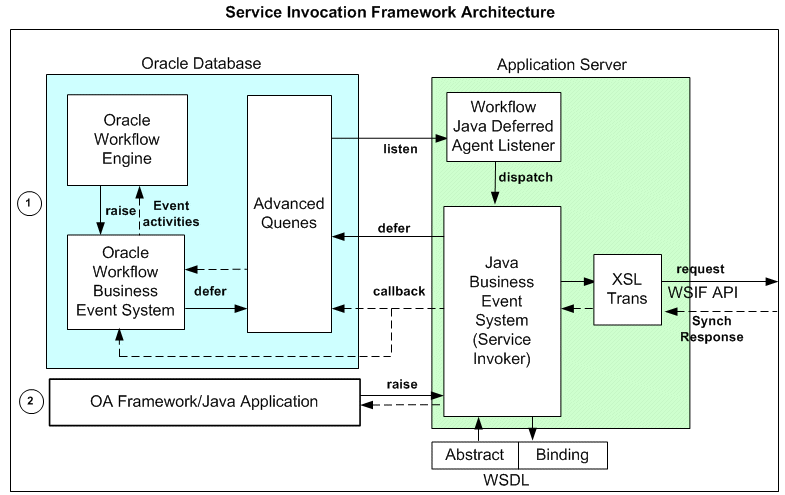Profile Options related to OAF
1. Disable Self-Service Personal (FND_DISABLE_OA_CUSTOMIZATIONS) :
This disables the rendering of all personalization that have been
created. If this system profile option is set to Yes, the configurations
made will not be applied, regardless of the level at which the
configurations were made. Only the original definition of each
self-service page will be displayed.
2. Personalize Self-Service Defn (FND_CUSTOM_OA_DEFINTION) :
This system profile option controls access to the Personalization
Framework. This profile option enables or disables the global
Personalize URL link that appears on each self-service web application
page for Admin-level customizations.
3. FND: Personalization Region Link Enabled (FND_PERSONALIZATION_REGION_LINK_ENABLED) :
Enables the "Personalize Region" links on a page if the Personalize
Self-Service Defn profile is set to Yes. Enabling the "Personalize
Region" links allows users to also personalize regions that are
dynamically added to the page from custom code in the controller.
4. Fnd Xliff Export Root Path (FND_XLIFF_EXPORT_ROOT_PATH) : Use
this profile option to set the root path used to generate the full path
where the Xliff files are exported to when users extract their
translated personalizations using the Extract Translation Files page.
5. Xliff Import Root Path (FND_XLIFF_IMPORT_ROOT_PATH) :
Use this profile option to set the root path used to derive the full
path from where the Xliff files are uploaded when users use the Upload
Translations page to upload translated personalizations.
6. FND: Personalization Document Root Path (FND_PERZ_DOC_ROOT_PATH) :
Use this profile option to define the root path where personalizations
documents are exported to or imported from when users use the Database
page or the File System page of the Functional Administrator
responsibility's Document Manager, respectively.
7. FND: Disable Partial Page Rendering (FND_PPR_DISABLED) :
Controls whether partial page rendering is disabled. If set to Yes, PPR
is disabled. In this case, UIX automatically renders a Go button next
to each item with a partialAction enabled.
8. Enable PPR Debugging (FND_ENABLE_PPR_DEBUGGING) :
Controls the PPR debugging feature. When this profile option is
enabled, the partial targets are displayed at the top of the screen as
the page renders.
9. FND: View Object Max Fetch Size (VO_MAX_FETCH_SIZE) :
By setting the value for this profile option, we can determine how many
records are fetched by View Objects in all of the EBS applications. The
profile value is set at site level to 200 by default, so it may need to
be changed to a more appropriate value depending on requirements.
Setting a large value can effect performance. The higher the value, the
longer pages will take to load. So it is best to set it at application
level e.g. Projects.
10. FND: Personalization Seeding Mode (FND_PERSONALIZATION_SEEDING_MODE) :
When the profile 'FND: Personalization Seeding Mode' is set to "Yes",
it sets the developerMode flag to "Yes" for any function level or user
level personalization. These personalizations are then protected against
update/delete. That personalization then can only be deleted from back
end using JDR_UTILS.deleteDocument.
11. FND: Passivation Level (PASSIVATION_LEVEL) : indicates whether passivation is enabled, and if so, at what level of frequency. (Resource Threshold/Request)
12. FND: Session Timeout Recovery Enabled (SESSION_TIMEOUT_RECOVERY_ENABLED) : It indicates whether servlet session time-out recovery is enabled for the application.
13. ICX: Limit Time (ICX_LIMIT_TIME) :
Indicates the amount of time after which the user, regardless of their
level of activity, will be asked to validate their credentials in order
to continue working.
14. ICX:Session Timeout (ICX_SESSION_TIMEOUT) : Maximum idle time for an Oracle Applications user session (specified in minutes).
15. FND: Disable Configurable Home Page (FND_CONFIG_HOMEPAGE_DISABLED) :
This profile is for retaining backward compatibility. It basically
determines whether the Configurable Home page is enabled or disabled.
16. FND: Disable Look Ahead LOV (FND_DISABLE_LOOK_AHEAD_LOV) :
Determines whether the Look Ahead LOV feature is enabled or disabled at
the Site or Application level. However, the value of Look Ahead Enabled
property set on the messageLOVInput item overrides this profile option
value.
17. Corporate Branding Image for Oracle Applications (FND_CORPORATE_BRANDING_IMAGE) : To
globally override the Oracle corporate branding image with your own
corporate branding image, set this profile option to the name of an
image file (GIF) that contains your corporate image. This image file
should be placed under the $OA_MEDIA directory.
18. ICX: Date format mask (ICX_DATE_FORMAT_MASK) :
This profile specifies the format used when displaying date fields.
When a field displays both date and time, the date component is
displayed in the format specified here.
19. Restrict Text Input (FND_RESTRICT_INPUT) : If
you develop code that fails to perform adequate input validation, there
is always the risk that an attacker may be able to inject dynamic
scripting content such as Javascript/vbscript, into Oracle E-Business
Suite, and run the script(s) in the context of a legitimate Oracle
E-Business Suite user. This is referred to as cross-site scripting.
Oracle Framework provides a feature called Cross-Site Script scanning
(XSS scanning), that provides added security to mitigate cross-site
scripting attacks. When requests are made to get a value or values for a
parameter by calling OA Framework methods, the XSS scanning feature
performs an automatic scan of the value or values for scripting content.
If scripting content is found, an exception is thrown, otherwise the
value or values are returned. To enable XSS scanning, set this profile
option to Yes at the Site level.
